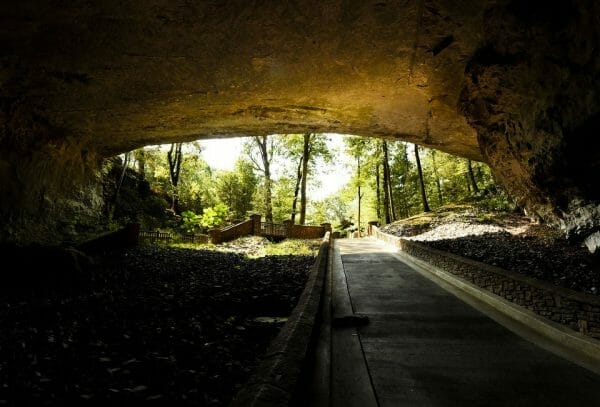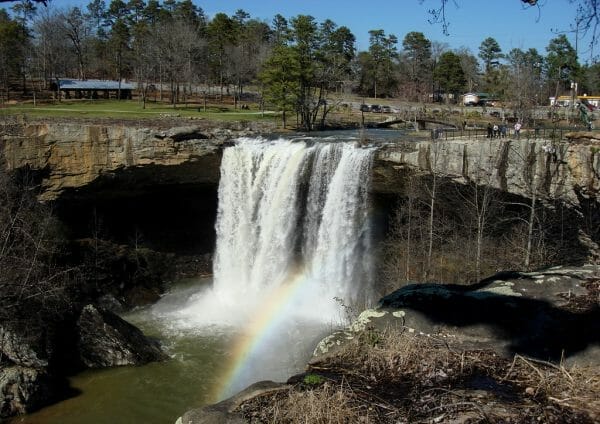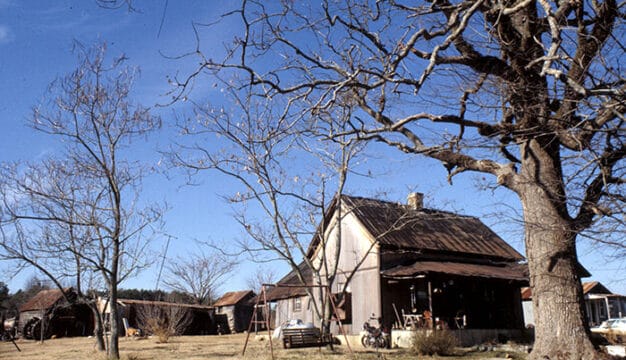Physiographic Sections of Alabama
 Cathedral Caverns Entrance
The characteristics of the Earth’s surface are the result of the interactions of those geologic processes that wear it away and those that rebuild it. Destructive processes include weathering, which is the disintegration or decomposition of stationary solid material by agents such as gravity and water, and erosion, which is the breaking down, loosening, and movement of solid material. Water, wind, and ice are the main agents of erosion. Much of our landscape is the result of differential erosion, the varying resistance of individual rocks to wearing down.
Cathedral Caverns Entrance
The characteristics of the Earth’s surface are the result of the interactions of those geologic processes that wear it away and those that rebuild it. Destructive processes include weathering, which is the disintegration or decomposition of stationary solid material by agents such as gravity and water, and erosion, which is the breaking down, loosening, and movement of solid material. Water, wind, and ice are the main agents of erosion. Much of our landscape is the result of differential erosion, the varying resistance of individual rocks to wearing down.
Geologic processes that build the landscape include deposition, magmatism, and deformation. Deposition is the addition of material, called sediment, that was eroded in one area to another part of the Earth’s surface. Magmatism is the generation, rise, and solidification of molten rock (magma) formed by partial melting of the Earth’s interior. Deformation is the change in size, shape, and location of material as a result of heat and stress.
Classification of Landscapes
 Noccalula Falls
Landscapes are classified in a hierarchical format (similar to biological classifications). Physiographic regions are the broadest (or first-order) divisions recognized for each continent. They are based on rock type and age, geologic structure, and history. North America is divided into eight separate physiographic regions. Each physiographic region is further divided into physiographic provinces, with each province being an area within a region whose pattern of relief features or landforms (physically recognizable features of the Earth’s surface with distinctive shapes and usually produced by natural causes) differs significantly from that of adjacent provinces. For example, the Appalachian Highlands region is divided into seven distinct provinces.
Noccalula Falls
Landscapes are classified in a hierarchical format (similar to biological classifications). Physiographic regions are the broadest (or first-order) divisions recognized for each continent. They are based on rock type and age, geologic structure, and history. North America is divided into eight separate physiographic regions. Each physiographic region is further divided into physiographic provinces, with each province being an area within a region whose pattern of relief features or landforms (physically recognizable features of the Earth’s surface with distinctive shapes and usually produced by natural causes) differs significantly from that of adjacent provinces. For example, the Appalachian Highlands region is divided into seven distinct provinces.
 Cheaha Mountain View
Each physiographic province is itself divided into physiographic sections, with each section containing essentially the same pattern of relief features or landforms as other sections in the province but distinguished on the basis of its geographic location. For example, the Valley and Ridge Province of the Appalachian Highlands region is divided into three sections, from north to south, being the Hudson Valley, Middle, and Tennessee sections. Each section can be divided into physiographic districts, each of which is an area within a section that is based on local landforms. For example, the Tennessee section of the Valley and Ridge province in Alabama is divided into seven districts.
Cheaha Mountain View
Each physiographic province is itself divided into physiographic sections, with each section containing essentially the same pattern of relief features or landforms as other sections in the province but distinguished on the basis of its geographic location. For example, the Valley and Ridge Province of the Appalachian Highlands region is divided into three sections, from north to south, being the Hudson Valley, Middle, and Tennessee sections. Each section can be divided into physiographic districts, each of which is an area within a section that is based on local landforms. For example, the Tennessee section of the Valley and Ridge province in Alabama is divided into seven districts.
Physiographic Sections of Alabama
According to Sapp and Emplaincourt, there are five physiographic sections in Alabama, three belonging to the Appalachian Highlands Region, and one each to the Inland Plains and the Atlantic Plain Regions.
Appalachian Highlands Region
Piedmont Province
Piedmont Upland Section: a plateau that slopes from the north (where elevations commonly exceed 1,000 feet above sea level) to the south, where its contact with the East Gulf Coastal Plain section commonly occurs at about 500 feet.
Valley and Ridge Province
Tennessee Valley and Ridge Section: an area of numerous zigzagging ridges separated by deep steep-sided valleys in the west and the broad valley of the Coosa River.
Appalachian Plateaus province
Cumberland Plateau Section: relatively flat uplands formed on Pennsylvanian sandstone and cut by three major valleys in northeast-southwest-trending, breached anticlines.
Interior Plains Region
Interior Low Plateaus Province
Highland Rim Section: two east-west valleys that formed in easily eroded limestone, and a low ridge between them that developed on more resistant sandstone.
Atlantic Plain Region
Coastal Plain Province
East Gulf Coastal Plain Section: although called a plain, a region that shows a wide variety of landscapes. In places, it is a flat, relatively featureless plain, but elsewhere it consists of rounded and eroded hills, cuestas, and flatwoods, and the floodplains of the Alabama and Black Warrior Rivers.
Further Reading
- Adams, G. I., et al. Geology of Alabama. Geological Survey of Alabama Special Report 14. Tuscaloosa, Ala.: Geological Survey of Alabama, 1926.
- Lacefield, James. Lost Worlds in Alabama Rocks. Revised edition. Tuscaloosa: Alabama Museum of Natural History, 2018.



